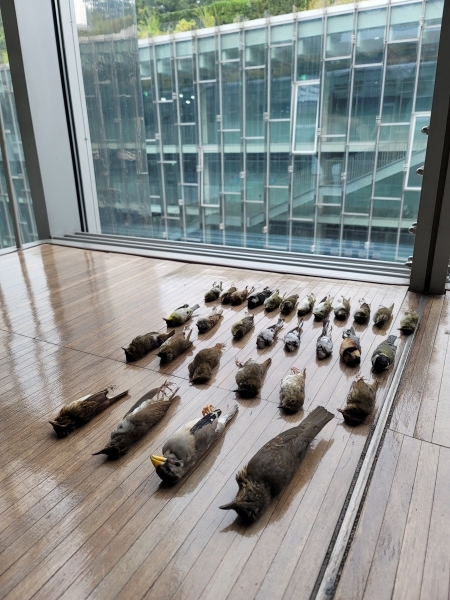
The Ewha Campus Complex (ECC), designed by a French architect Dominique Perrault, is arguably Ewha’s most notable landmark and has been the center of campus life. However, the structure is also renowned for a more sinister reason. In the 13 years since the establishment of ECC, there have been countless cases of birds flying into the windows of the building being killed.
To resolve and publicize this incident, the Window Strike Monitoring Team was formed by students at Ewha. Since October 2019, the team has been posting records of birds that have collided with the windows of ECC on their official Instagram account.
Kim Yun-jeon, who finished her undergraduate studies at Ewha and is currently studying for a Master’s degree in Life Sciences at Ewha’s graduate school, is the leader of the Window Strike Monitoring Team.
Window strike, also known as bird window collision, is when birds unwittingly collide with glass parts of structures due to the transparency and reflectivity of the surface. According to Kim, approximately 7.65 million birds collide with buildings and a further 230,000 collide with soundproof walls each year in Korea. Turning to Ewha’s figures, out of the 228 birds that have struck windows recorded by Window Strike Monitoring Team since May 30, 2019, 163 birds are estimated to have collided with the windows of ECC.
The ultimate goal of the Window Strike Monitoring Team is to prevent innocent birds from being killed by windows of school buildings. They strive to achieve this goal by collecting data through reporting window strikes on campus and promoting ways to reduce window collisions. Their efforts do not stop there, but extends to rescuing injured birds.
“There is a possibility that the birds mistake the sky and shrubs reflected on the glass surface at the top of ECC for being real,” Kim said. “Also, several shrubs in the ECC garden provide habitats for birds, which may have caused an increase in birds moving towards ECC. The valley-like structure also causes secondary damage for birds that strike the building, preventing them from escaping ECC and leading to additional collisions.”
Kim suggested the most basic and familiar solution, the 5X10 rule, to stop more damage from occurring. The rule requires a five centimeter upper and lower spacing, and a 10 centimeter left and right spacing to be applied on a pattern on the glass to prevent window strikes. Patterns include dots, lines, and other various forms. Other ways include hanging parachute cords vertically in front of windows and attaching tape on windows to enables birds to see the glass.
Kang Sung-gi, a member of the school’s architecture team who manages buildings on campus and is currently in charge of ECC, shared the school’s official response regarding this issue.
Kang stated that the school is also aware of this issue and have looked over the possible solutions for quite a long time. Prey-shaped films such as eagles which are known to prevent birds from approaching windows were not found to be very effective. Consequently, the school is planning to construct reduction measures with the 5X10 bird tapes on the southern part of the Research Cooperation Building next year.
“Collisions at ECC are especially difficult to resolve due to the cost of preventative construction and the complex structure of the building,” Kang mentioned. “However, the school is striving to find solutions that can be applied at ECC by testing out alternatives such as ultrasonic waves that prevent birds from flying into glass windows.”
Kang stated that realistic concerns such as the difficult financial situation of the school and changes to the exterior of campus buildings cannot be ignored. However, he ended the interview with a positive remark, stating that if each individual starts to pay attention to this problem, it will definitely lead to a desirable environment where both nature and people can live together in harmony.


